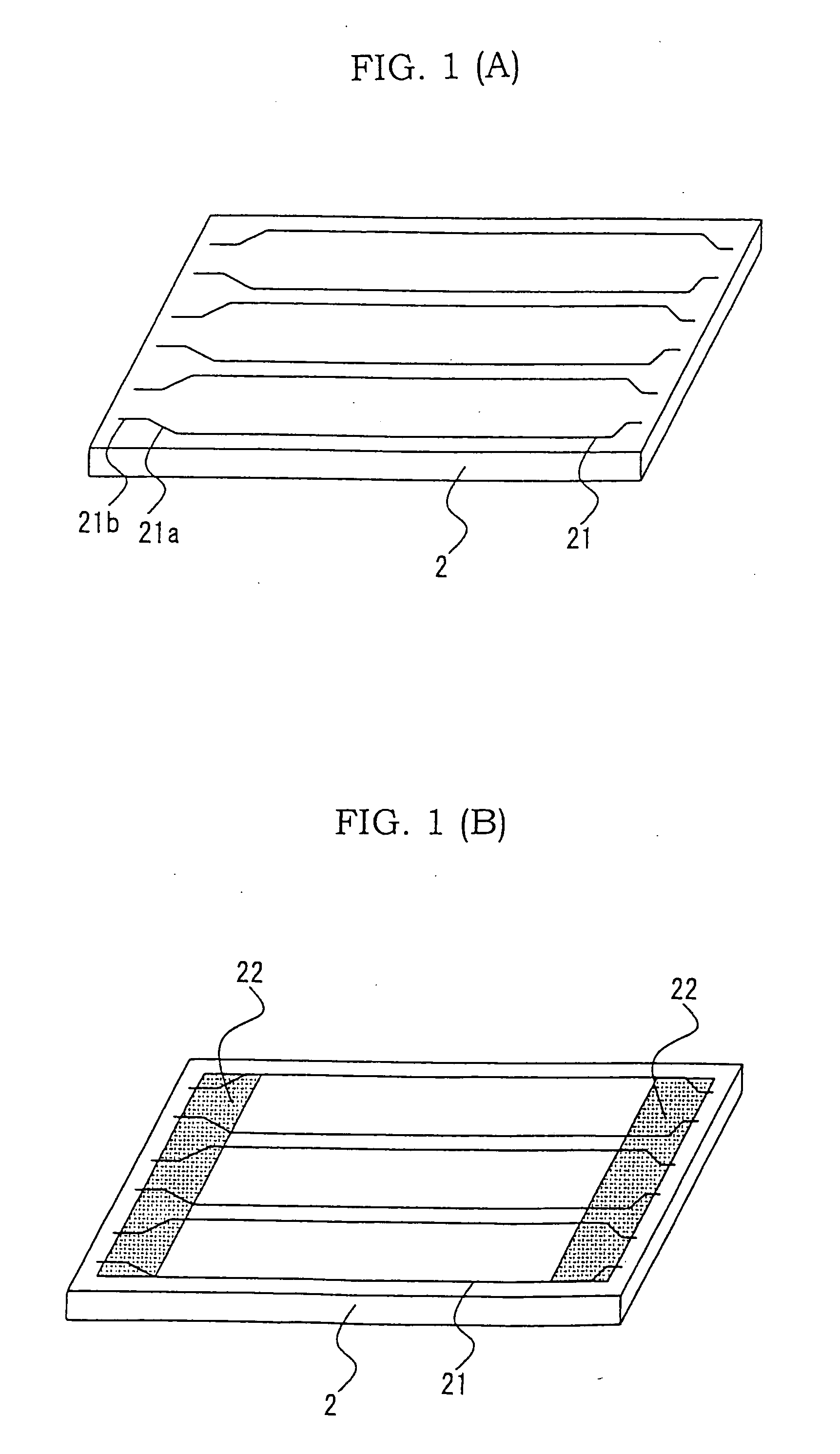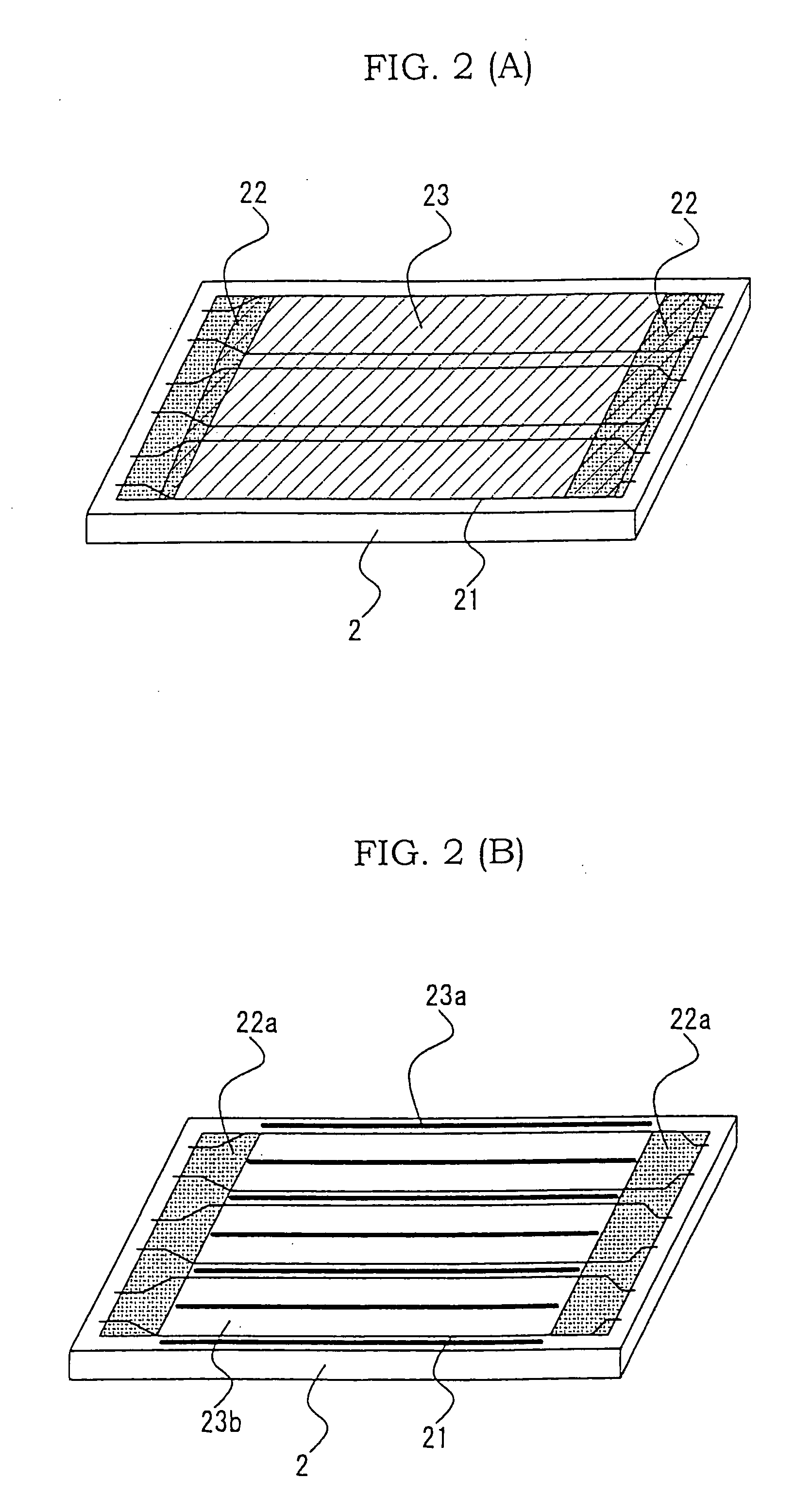Method of manufacturing a plasma display panel
a technology of plasma display panel and manufacturing method, which is applied in the manufacture of electric discharge tubes/lamps, cold cathode manufacturing, and the manufacture of electromechanical systems, etc., can solve the problems of reducing the use efficiency of material layers, reducing the number of steps needed for forming ribs, and remarkably increasing the production cost of ribs
- Summary
- Abstract
- Description
- Claims
- Application Information
AI Technical Summary
Benefits of technology
Problems solved by technology
Method used
Image
Examples
first embodiment
the Present Invention
[0025] A method of manufacturing a PDP according to a first embodiment of the present invention is explained referring to FIGS. 1-4. FIGS. 1-3 are views for showing the state of a substrate with ribs after the steps of manufacturing the PDP according to the first embodiment. FIG. 4(A) illustrates a top view of an essential portion of the PDP according to the first embodiment and FIG. 4(B) illustrates a sectional view of the essential portion of the PDP according to the first embodiment.
[0026] The method of manufacturing the PDP of the first embodiment can be roughly divided into two processes. One process is to form a front panel assembly of the PDP. The other process is to form a rear panel assembly having ribs thereof. Here, explanation of the process of forming the front panel assembly is omitted since the front panel assembly can be formed by a typical technique and the process of forming the rear panel assembly will be described below.
[0027] The rear pane...
second embodiment
the Present Invention
[0036] A method of manufacturing a PDP according to a second embodiment of the present invention will be explained below. The PDP manufacturing method of the present invention is based on the premise that a molding process is employed. The molding process presents the following problem of the rib formation. Where the rib formation is performed by the molding process according to an ordinary method of manufacturing the PDP, edge portions of the rib paste 23 are spread when the rib paste 23 is patterned into a predetermined shape by pressing the thin plate elastic mold against the paste 23. For this reason, the rib paste 23 spreads to the outside of an appropriate region where ribs are to be formed. Specifically, it may spread over the lead portion 2b (see FIG. 4(A)) to the terminal portion 2c. Consequently, the rear substrate 2 at the terminal portion 2c is provided with a two-layer structure constituted of the terminal protective paste 22 and rib paste 23 and wh...
third embodiment
the Present Invention
[0042] A PDP manufacturing method according to a third embodiment of the present invention is performed in substantially the same manner as in the first and second embodiments, except that a photo-cure organic binder is used as an organic binder for the terminal protective paste 22 and the protective paste 22 is cured by the irradiation of light.
[0043] When the thermosetting organic binder is used as the organic binder, the terminal protective paste needs to be dried after it is applied. In general, the drying is performed by heating the substrate up to a temperature of approximately 100-200° C., but this substrate temperature needs to be lowered after the drying. If the formation of ribs is performed without lowering the substrate temperature, the substrate will be shrunk at about 7 ppm / ° C. and the accuracy of the ribs will be deteriorated. For these reasons, the lowering of substrate temperature is performed in order to keep the accuracy of the rib formation...
PUM
 Login to View More
Login to View More Abstract
Description
Claims
Application Information
 Login to View More
Login to View More - R&D
- Intellectual Property
- Life Sciences
- Materials
- Tech Scout
- Unparalleled Data Quality
- Higher Quality Content
- 60% Fewer Hallucinations
Browse by: Latest US Patents, China's latest patents, Technical Efficacy Thesaurus, Application Domain, Technology Topic, Popular Technical Reports.
© 2025 PatSnap. All rights reserved.Legal|Privacy policy|Modern Slavery Act Transparency Statement|Sitemap|About US| Contact US: help@patsnap.com



